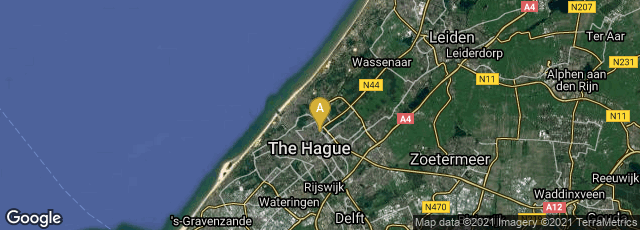

A: Centrum, Den Haag, Zuid-Holland, Netherlands
In 1659 Dutch mathematician, astronomer, physicist and horologist Christiaan Huygens published his discovery of Saturn's ring and and many other observations on the planets and their satellites in Systema Saturnium, sive de causis mirandorum Saturni phaenomenon, et comite ejus planeta novo in The Hague. With an improved telescope which he built with his brother Constantijn, and a theory based upon the Cartesian concept of vortices, Huygens was able to solve the problem of the "arms" of Saturn, whose existence and variable aspect had puzzled astronomers since their discovery by Galileo. Huygens hypothesized that the varying "arms" were actually the phases of a single thin flat ring, surrounding but not touching the planet, and inclined at an angle of twenty-eight degrees to the ecliptic.
"The rest of Systema Saturnium is an exhaustive exposition of how this ring, which stays parallel to itself, can account for all Saturn’s appearances, fixing its inclination to the ecliptic and its points of intersection with the ecliptic, and making predictions as to when future appearances will be seen. The lucidity of the tract is well-illustrated by the explanatory figure used by Huygens, which is still used today to explain the appearances” (Van Helden, pp. 161-162).
Huygens’ Saturn ring theory aroused some controversy among his fellow astronomers, in part because of his disparaging remarks about the superiority of his telescopes to their own, and in part because of his advocacy of the Copernican system. One of those upset by Huygens’ work was the French Jesuit mathematician and physicist Honoré Fabri, who took exception to Huygens’ frank Copernicanism. Fabri teamed up with the optical instrument maker Eustachio Divini, whose telescopes had supposedly been slighted by Huygens, and in the summer of 1660 a polemic tract entitled Brevis annotatio in systema Saturnium appeared in Rome. Though Divini’s name appeared on the title page, it was written by Fabri. Fabri rejected Huygens’ ring hypothesis, postulating instead that Saturn had two massive but dark satellites close to the planet and two small but bright satellites farther out, which would account for all the planet’s observed appearances. “It was not difficult for Huygens to find fault with this hypothesis, and he quickly issued a reply, entitled Brevis assertio systematis Saturni, in which he pointed out that the outline of the anses [arms] is elliptical, not circular, and also challenged Fabri to find the appropriate periods of these supposed satellites” (Van Helden, p. 165).
To preserve his priority in the discovery before he was ready to publish in detail Huygens had presented this solution three years earlier in a single-sentence anagram at the end of his "De Saturni luna observatio nona," published in Borel's De vero telescope inventore (1656).
Van Helden, “’Annulo cingitur’: The solution of the problem of Saturn,” Journal for the History of Astronomy 5 (1974) 155-173. Hook & Norman, The Haskell F. Norman Library of Science and Medicine (1991) no. 1136.